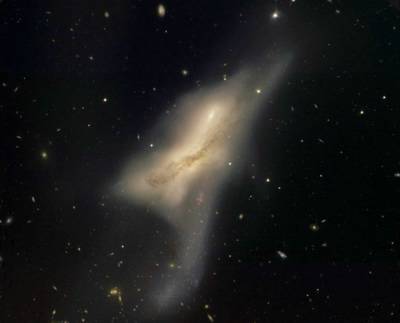At a distance of about one hundred million light years from Earth, two galaxies are seen in their collision stages, while providing us with a glimpse into the mystery of the final fate of our planet when the Milky Way will merge in a fatal merger with our neighboring galaxy - Andromeda.
Avi Blizovsky

This is what a collision between the Milky Way and Andromeda might look like Click to enlarge. NGC 520. Photo: Gemini Observatory
In the direction of a group of fish, and at a distance of about one hundred million light years from Earth, two galaxies are seen in their collision stages, while providing us with a glimpse into the mystery of the final fate of our planet when the Milky Way will merge in a fatal merger with our neighboring galaxy - Andromeda.
The image of the merging galaxies was taken on the night of July 13-14, 2005 by the Gemini Multi-Object Spectrograph (GMOS) on the 8-meter telescope at the Gemini North Observatory in Mauna Kea, Hawaii.
Prof. Ian Robinson, director of the Astronomical Technology Center in Great Britain, which built GMOS in collaboration with other parties, said: "It's quite scary. Since GMOS was installed on the telescope in 2001 it has taken the most spectacular astronomical images of faint, distant galaxies and star-forming regions, providing a wealth of scientific data, but this image in particular captivated me. Our luck is that we have another 5 billion years left before we are swallowed up by Andromeda. In any case, it is amazing to see long in advance how the earth and our galaxy as a whole will end their lives. I'm glad I won't be around when the fireball happens.
The image of the combined galaxies, cataloged as a single galaxy called NGC 520, are in a fairly early stage of the galactic dance of death and may have changed completely in the time it took for their light to reach Earth.
Prof. Robinson added: "Clues to the formation of new stars due to the shock of this merger can be seen in the form of the areas illuminated in pale red above and below the center of the image. It is possible that even now the galaxies have completely merged and formed a new galaxy with a completely new set of stars and planets surrounding them. It is possible that new life is being created on these planets.
NGC 520's unique shape is due to a collision. The dust line of one of the galaxies is easily visible in the foreground of the image and a distant tail is visible in the central part of the bottom of the image. These formations were created as a result of the mutual gravitational action that distorted the original shape of the two galaxies.
